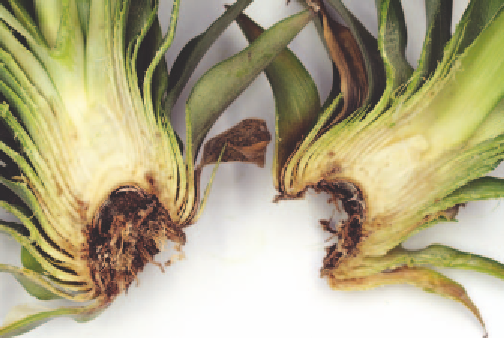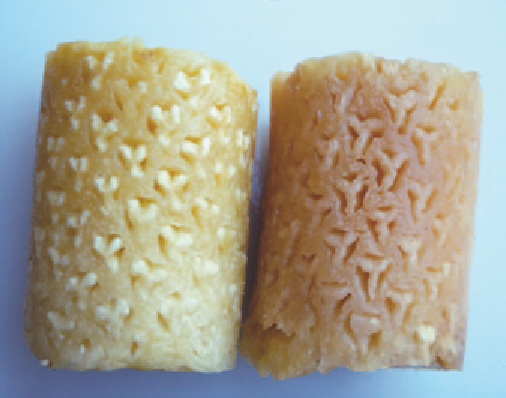Agriculture Reference
In-Depth Information
PINK DISEASE
Management
•
■
Management is not warranted in Queensland.
Cause
Pink disease is caused by undetermined species of bacteria
in Queensland. In Hawaii, several bacteria are involved,
including
Pantoea citrea
,
Gluconobacter oxydans
or
Acetobacter aceti
.
Smooth Cayenne is relatively resistant.
•
FUNGI
Symptoms
Infected fruit do not show any external symptoms, even
when fully ripe. Internally, the f flesh may be water-soaked
or light pink and have an aromatic odour, although these
symptoms may not be obvious immediately. When sterilised
by heat during canning, infected tissue darkens to colours
ranging from pink to dark brown. In some fruit, only one or
a few fruitlets may be infected. In highly translucent,
low-brix fruit, the entire cylinder can be invaded.
BASE (BUTT) ROT
■
Cause
The fungus
Chalara paradoxa
,
which also causes white leaf
spot and water blister.
Symptoms
Symptoms are seen only on crowns, slips and suckers before,
or immediately after, planting. A grey to black rot of the soft
butt tissue develops, leaving stringy fibres and a cavity at the
base of the stem. If affected material is planted, partial decay
of the butt severely reduces plant growth. When butt decay is
severe, plants fail to establish, wilt rapidly and leaf tissue
dies. Unlike Phytophthora heart rot, the young leaves remain
firmly attached to the top of the stem. Infected plants can
easily be broken off at ground level.
Source of infection and spread
The bacteria infect through the open f flower during cool
weather. Disease incidence increases in dry conditions
before f flowering, followed by rainfall during f flowering.
The bacteria are thought to be carried by nectar-feeding
insects and mites to open f flowers from infected, decaying
fruit near f flowering fields.
Source of infection and spread
The fungus is important in the breakdown of pineapple
residues after cropping. It survives as chlamydospores in
soil and decaying pineapple residues. It enters only through
wounds and is most active in warm, wet weather. The
fungus commonly infects plants through fresh wounds
occurring where the planting material has been detached
from the parent plant. These infections often begin to
develop while planting material is stored and may not be
Importance
This disease occurs only sporadically when fruit develop
under cool, wet conditions. Since the bacteria are killed by
high temperatures, pink disease occurs mainly in spring in
Queensland (September-October). The incidence of
infected fruit is very low.
Fig 16.3 A healthy fruit cylinder (left) compared with one affected by
pink disease.
Fig 16.4 Base (butt) rot. This disease destroys the soft tissue at the
base of the stem.













